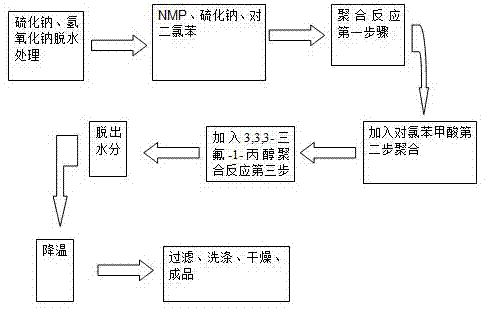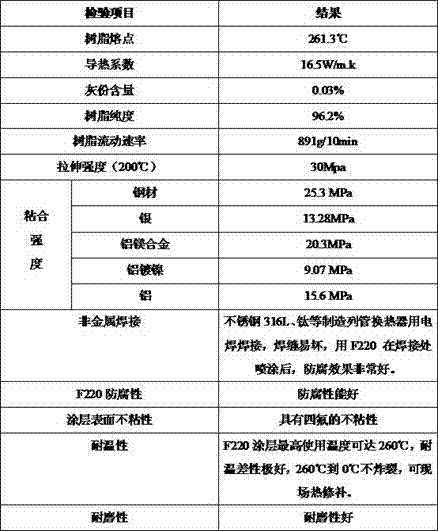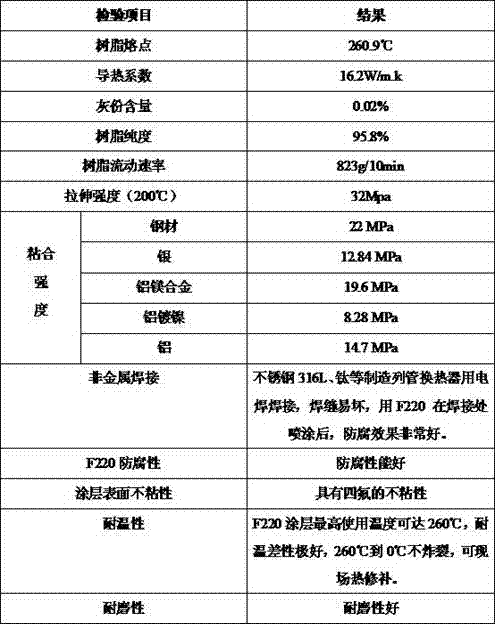A kind of preparation method of f220 resin
A technology of resin and sodium sulfide, applied in anti-corrosion coatings, fire-retardant coatings and other directions, can solve the problems of easy peeling or falling off in vacuum environment, low adhesion strength of finished products, complicated preparation process, etc., and achieves simple and easy preparation method and high yield of finished products. , The effect of low preparation cost
- Summary
- Abstract
- Description
- Claims
- Application Information
AI Technical Summary
Problems solved by technology
Method used
Image
Examples
Embodiment 1
[0021] In a 1L titanium autoclave, add 336g of sodium sulfide (Na 2 S.5H 2 O), sodium hydroxide 4g, N-methylpyrrolidone 800ml, in 99.99%N 2 Under the protection of gas, heat the temperature to 110°C for 8 hours, remove 80g of water, NMP flows back into the reactor, the temperature rises to 235°C, add 147g of p-dichlorobenzene with a metering pump, and keep at this temperature for 2h . The obtained polymer mixed slurry was lowered to 127°C at a cooling rate of 20°C / min, and then 156.5g of p-chlorobenzoic acid and 85g of sodium acetate were added to the reaction kettle, and then the temperature was raised to 255°C and kept for 0.5h. Polymer mix paste. Dissolve 150.3g of 3,3,3-trifluoro-1-propanol in 200ml of N-methylpyrrolidone and control the temperature at 255°C through a metering pump, and gradually add it dropwise into the reactor for 1 hour. Stabilize the temperature at 255°C to release the pressure, discharge 45g of water, and then continue to control the reaction at 2...
Embodiment 2
[0025] In a 1L titanium autoclave, add 336g of sodium sulfide (Na 2 S.5H 2 O), sodium hydroxide 4g, N-methylpyrrolidone 800ml, in 99.99%N 2 Under the protection of gas, heat the temperature to 130°C, remove 80g of water, NMP flows back into the reactor, the temperature rises to 240°C, add 147g of p-dichlorobenzene with a metering pump, and keep at this temperature for 2h. The obtained polymer mixed slurry was lowered to 133°C at a cooling rate of 20°C / min, then 172.1g of p-chlorobenzoic acid and 85g of sodium acetate were added to the reaction kettle, and then the temperature was raised to 265°C and kept for 0.5h. Polymer mix paste. Dissolve 150.1g of 3,3,3-trifluoro-1-propanol in 200ml of N-methylpyrrolidone and control the temperature at 265°C through a metering pump, and gradually add it dropwise into the reactor for 1 hour. Stabilize the temperature at 265°C to release the pressure, discharge 45g of water, and then continue to control the reaction at 265°C for 4.5 hours...
Embodiment 3
[0029] In a 1L titanium autoclave, add 336g of sodium sulfide (Na 2 S.5H2O), sodium hydroxide 4g, N-methylpyrrolidone 800ml, in 99.99%N 2 Under the protection of gas, the temperature was heated to 120°C, 80g of water was removed, NMP flowed back into the reactor, and the temperature rose to 238°C, 161.7g of p-dichlorobenzene was added by a metering pump, and kept at this temperature for 2h. The obtained polymer mixed slurry was lowered to 130°C at a cooling rate of 20°C / min, then 200.1g of p-chlorobenzoic acid and 85g of sodium acetate were added to the reaction kettle, and then the temperature was raised to 258°C and kept for 0.5h. Polymer mix paste. Dissolve 150.6g of 3,3,3-trifluoro-1-propanol in 200ml of N-methylpyrrolidone and control the temperature at 262°C through a metering pump, and gradually add it dropwise into the reaction kettle for 1 hour. Stabilize the temperature at 258~261°C to release the pressure, discharge 45g of water, and then continue to control the r...
PUM
| Property | Measurement | Unit |
|---|---|---|
| melting point | aaaaa | aaaaa |
| tensile strength | aaaaa | aaaaa |
| melting point | aaaaa | aaaaa |
Abstract
Description
Claims
Application Information
 Login to View More
Login to View More - R&D
- Intellectual Property
- Life Sciences
- Materials
- Tech Scout
- Unparalleled Data Quality
- Higher Quality Content
- 60% Fewer Hallucinations
Browse by: Latest US Patents, China's latest patents, Technical Efficacy Thesaurus, Application Domain, Technology Topic, Popular Technical Reports.
© 2025 PatSnap. All rights reserved.Legal|Privacy policy|Modern Slavery Act Transparency Statement|Sitemap|About US| Contact US: help@patsnap.com



